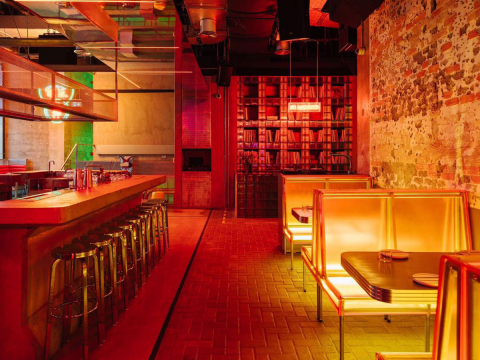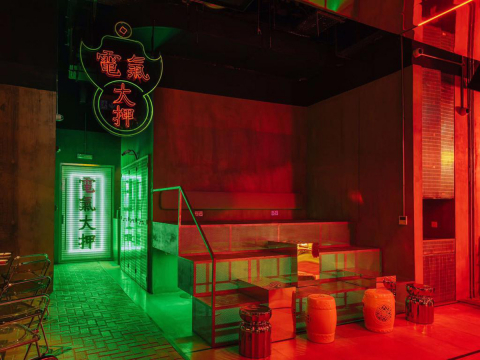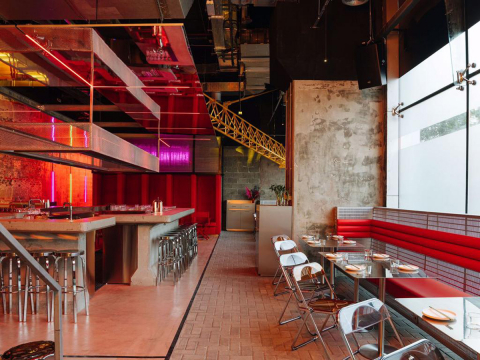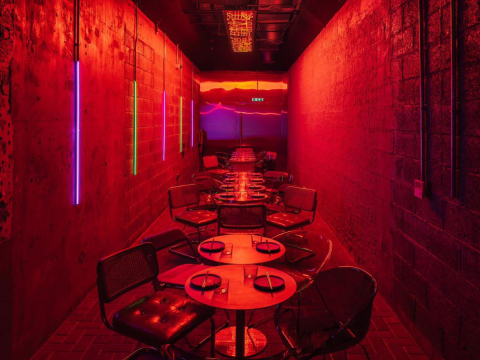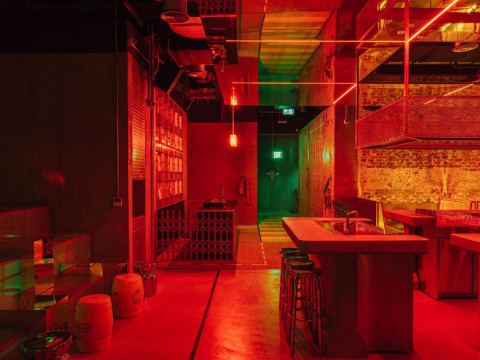Electric Pawn Shop
Electric Pawn Shop takes birth as an F&B bar in the back of the H-Hotel, reading the traces of the restaurant that was once there. It projects to the inside the movement, light and speed of the cars on the second of November bridge, generating a theatrical play of reflections.
The project takes its inspiration from the 70’s Chinatown of New York —replicating its dark and dystopian vibe—whilst staying true to the essence of UAE’s culture. Consequently, the metropolitan environment shaping the bar is characterized by an after-dark dining feel, retro chairs, and red neon interiors where good music and exotic cuisine could merge to create a holistic sensory experience. We envisioned creating a new nightlife atmosphere unfolding a new generation of Asian bars through a venue that fuses counter culture and underground music. The limitations and possibilities of the tenant space were something we took into consideration, as we looked deep into its left-over textures.
At the heart of the 300 sqm project is a sculptural fragmented bar, formed by four bridge concrete beams, standing majestically as the central element for the design. Resting on the bar, one is aware of the play of scale through a hovering mirror canopy that reveals the structure and reflection of different light colors, contrasting with the stiffness of the rough materials and unveiling the three-dimensionality of the space. The visitor feels the structural tension by peeking through the void of the architectonic mirror, seeing steel I-beams, tension cables, and a yellow crane bolted into the back wall. Adding to the honesty of this palimpsest, pumps and brackets render the ceiling a multi-layered canvas.
Through its different treatments, the floor acts as a navigation map from one zone to another. Guided by neon signs, the visitors experience unique adventures while discovering glimpses of the events that are yet to unfold. From one end, the alleyway with its street furniture culminates at an elusive stainless reflective façade, creating a dreamy atmosphere.
Wagon seating, couple seating, a common dining area and a metallic amphitheater, generate artificial topographies putting the users in closer proximity suitable for amiable gatherings and chance encounters. Couple seats face the main bar, extending from the ground to the ceiling. On the sides, the user is entirely sequestered by the seat, deliberately reducing stimuli and allowing a more private setting for conversation. Embraced by a state of “emptiness”, the green enclosed valentine room projects informal events which typically happen in the leftover corners of the city. A vinyl museum exposes a fine selection of records and, through the glass blocks of its shelving unit disperses an amalgam of different colors into the bar. The space acts as an autobiography, where each design decision takes inspiration from food, music and cocktails, telling the story of the client, the DJ, the chef and the architect.
Rough materials such as concrete, perforated metal sheets, glass blocks, GI metal, neon lighting, brick pavement, water and mirrors create a playful imaginative environment. The concept of pairing neon lights with rough finishes and textures creates a retro experience with an authentic atmosphere of nostalgic vitality. Highlighting every zone of the space with a different color allows the user to easily navigate the bar. Linear lights line up every corner of the space contouring its different elements, while accentuating the overall ambiance of the bar. The central area relies on the use of red neon lights, whereas purple and green linear lights revitalize the alleyway walls, and the main entrances are marked by a green neon glow.
Mimicking the city of Dubai, the phenomenon generated by Electric Pawn Shop, changes our perception of reality by the second, making the visitor wonder if their experience is real or a mere illusion.




